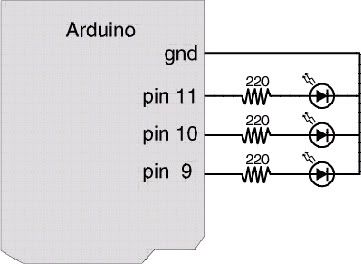Assignment: Digital I/O with Arduino Boards + Diffuser
Collaborators:


More photos of this project: (Lab2_Digital_Input_and_Output_with_Arduino_0.pdf)
Description:
A project that uses the Arduino board and programming environment to demonstrate how to make Three LED’s work according to a programmable/ adjustable interval.
Components List:
Notes:
I used the tutorial code found on the class website. One difference from spec: I attached the LED’s directly to ground, as I did not have elegantly sized connecting wires.
Acknowledgments:
With Michael’s and nick’s insight I was able to finish smoothly and without any glitches.
Code used in this Assignment:
/*
* Serial RGB LED* ---------------
* Serial commands control the brightness of R,G,B LEDs
** Command structure is "<colorCode><colorVal>", where "colorCode" is
* one of "r","g",or "b" and "colorVal" is a number 0 to 255.
* E.g. "r0" turns the red LED off.
* "g127" turns the green LED to half brightness
* "b64" turns the blue LED to 1/4 brightness
*
* Alternate command structure is "<colorCode>*", where "colorCode" is
* one of "r","g", or "b".
* E.g. "r" increases the red LED brightness by 10* "rrr" increases the red LED brightness by 30
* "ggb" increases the green LED brightness by 20 and the blue by 10
*
* Created 18 October 2006
* copyleft 2006 Tod E. Kurt <tod@todbot.com
* http://todbot.com/
*
* Adapted 5 September 2007
* copylefter 2007 Ryan Aipperspach <ryanaip@alumni.rice.edu>
*
*/
//include support for manipulating strings.
//for a useful string comparison function, see the bottom of this file... stringsEqual()
//#include <stdio.h>//#include <string.h>
char serInString[100]; // array that will hold the different bytes of the string. 100=100characters; // -> you must state how long the array will be else it won't work properlychar colorCode;
int colorVal;
int redPin = 9; // Red LED, connected to digital pin 9
int greenPin = 10; // Green LED, connected to digital pin 10int bluePin = 11; // Blue LED, connected to digital pin 11
int redValue = 127;
int greenValue = 127;
int blueValue = 127;
void setup() {pinMode(redPin, OUTPUT); // sets the pins as output
pinMode(greenPin, OUTPUT);
pinMode(bluePin, OUTPUT);
Serial.begin(9600);analogWrite(redPin, redValue); // set them all to mid brightness
analogWrite(greenPin, greenValue); // set them all to mid brightness
analogWrite(bluePin, blueValue); // set them all to mid brightness
Serial.println("enter color command (e.g. 'r43 or rrrrrrrrbbbb') :");
}
void loop () { //read the serial port and create a string out of what you read readSerialString(serInString, 100); //UNCOMMENT ONE OF THE FOLLOWING COMMANDS, OR NOTHING WILL HAPPEN WHEN YOU //RUN THE PROGRAM... //Uncomment the following line to read commands of the form 'r245' or 'b3'
//processNumericalCommands(serInString); //Uncomment the following line to read commands of the form 'rrrb' //processRepeatKeyCommands(serInString, 100); //Or write your own function... //YOUR_FUNCTION_HERE(serInString); //Erase anything left in the serial string, preparing it for the //next loopresetSerialString(serInString, 100);
delay(100); // wait a bit, for serial data
}
void resetSerialString (char *strArray, int length) { for (int i = 0; i < length; i++) { strArray[i] = '\0'; }}
//read a string from the serial and store it in an array
//you must supply the array variable
void readSerialString (char *strArray, int maxLength) { int i = 0; if(!Serial.available()) { return; } while (Serial.available() && i < maxLength) { strArray[i] = Serial.read(); i++; }}
//go through the string, and increase the red value for each 'r',
//the green value for each 'g', and the blue value for each 'b'.
//For example "rrrg" increases red by 30 and green by 10.
void processRepeatKeyCommands(char *strArray, int maxLength) { int i = 0; //loop through the string (strArray) //i = the current position in the string //Stop when either (a) i reaches the end of the string or// (b) there is an empty character '\0' in the string
while (i < maxLength && strArray[i] != '\0') { //Read in the character at position i in the string colorCode = serInString[i]; //If the character is r (red)... if (colorCode == 'r') { //Increase the current red value by 10, and if you reach 255 go back to 0 redValue = (redValue + 10) % 255; analogWrite(redPin, redValue); Serial.print("setting color r to "); Serial.println(redValue); //If the character is g (green)... } else if (colorCode == 'g') { greenValue = (greenValue + 10) % 255; analogWrite(greenPin, greenValue); Serial.print("setting color g to "); Serial.println(greenValue); //If the character is b (blue)... } else if (colorCode == 'b') { blueValue = (blueValue + 10) % 255; analogWrite(bluePin, blueValue); Serial.print("setting color b to "); Serial.println(blueValue); } //Move on to the next character in the string //From here, the code continues executing from the "while" line above... i++; }}
//change the value of the red, green, or blue LED according to the command received.
//for example, r240 sets the red LED to the value 240 (out of 255)
void processNumericalCommands(char *strArray) { //read in the first character in the string colorCode = serInString[0]; //if the first character is r (red), g (green) or b (blue), do the following... if( colorCode == 'r' || colorCode == 'g' || colorCode == 'b' ) { //convert the string to an integer //(start at the second character, or the beginning of the string '+1') colorVal = atoi(serInString+1); Serial.print("setting color "); Serial.print(colorCode); Serial.print(" to "); Serial.print(colorVal); Serial.println(); if(colorCode == 'r') analogWrite(redPin, colorVal); else if(colorCode == 'g') analogWrite(greenPin, colorVal); else if(colorCode == 'b') analogWrite(bluePin, colorVal); }}
//compare two strings to see if they are equal
//compares the first 'numCharacters' characters of string1 and string2 to
//see if they are the same
//
//E.g. stringsEqual("hello","hello",5) => true// stringsEqual("hello","helaabbnn",3) => true// stringsEqual("hello","helaa",5) => falseboolean stringsEqual(char *string1, char *string2, int numCharacters) { if (strncmp(string1, string2, numCharacters) == 0) { return true; } else { return false; }}